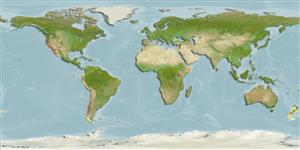Environment: milieu / climate zone / depth range / distribution range
Sinh thái học
Biển; Thuộc về nước lợ gần đáy; Mức độ sâu 0 - 280 m (Ref. 34024). Subtropical; 47°N -
Eastern Pacific: Washington, USA to Baja California and Ecuador. Record from the Gulf of California is doubtful.
Bộ gần gũi / Khối lượng (Trọng lượng) / Age
Maturity: Lm ? range ? - ? cm
Max length : 40.4 cm TL con đực/không giới tính; (Ref. 30541); common length : 30.0 cm TL con đực/không giới tính; (Ref. 55763)
Short description
Khóa để định loại | Hình thái học | Sinh trắc học
Các tia vây lưng cứng (tổng cộng) : 0; Các vây lưng mềm (tổng cộng) : 187 - 229; Tia cứng vây hậu môn: 0; Tia mềm vây hậu môn: 150 - 181; Động vật có xương sống: 86 - 91. Head naked; scales on body in basketweave pattern; precaudal vertebrae 18-19; swim bladder in males with posterior opening; body and head with numerous dark spots and blotches (Ref. 34024). Branchiostegal rays: 7 (Ref. 36413). Pelvic fin consists of one ray with two branches of unequal length (Ref. 36413).
Uncommon species found on sandy bottom from the shore to 280 m (Ref. 34024). Adults often burrow tail-first in sand, live in mucus-lined holes (Ref. 2850), mud, eelgrass and rock rubble (Ref. 36413). Mostly active at night and on overcast days (Ref. 2850). Important food for sea lions and cormorants (Ref. 2850). Oviparous, with planktonic larvae and extended pelagic juvenile (Ref. 36413). Oval, pelagic eggs float in a gelatinous mass (Ref. 205).
Nielsen, J.G., D.M. Cohen, D.F. Markle and C.R. Robins, 1999. Ophidiiform fishes of the world (Order Ophidiiformes). An annotated and illustrated catalogue of pearlfishes, cusk-eels, brotulas and other ophidiiform fishes known to date. FAO Fish. Synop. 125(18):178p. Rome: FAO. (Ref. 34024)
IUCN Red List Status (Ref. 130435)
Threat to humans
Harmless
Human uses
Các nghề cá: không ích lợi (thú vị)
Các công cụ
Special reports
Download XML
Các nguồn internet
Estimates based on models
Preferred temperature (Ref.
123201): 9.3 - 15.1, mean 11.3 °C (based on 51 cells).
Phylogenetic diversity index (Ref.
82804): PD
50 = 1.0000 [Uniqueness, from 0.5 = low to 2.0 = high].
Bayesian length-weight: a=0.00102 (0.00046 - 0.00225), b=3.06 (2.88 - 3.24), in cm total length, based on all LWR estimates for this body shape (Ref.
93245).
Mức dinh dưỡng (Ref.
69278): 4.1 ±0.57 se; based on food items.
Generation time: 2.9 ( na - na) years. Estimated as median ln(3)/K based on 1
growth studies.
Thích nghi nhanh (Ref.
120179): Trung bình, thời gian nhân đôi của chủng quần tối thiểu là 1.4 - 4.4 năm (K=0.3).
Fishing Vulnerability (Ref.
59153): Low to moderate vulnerability (32 of 100).
